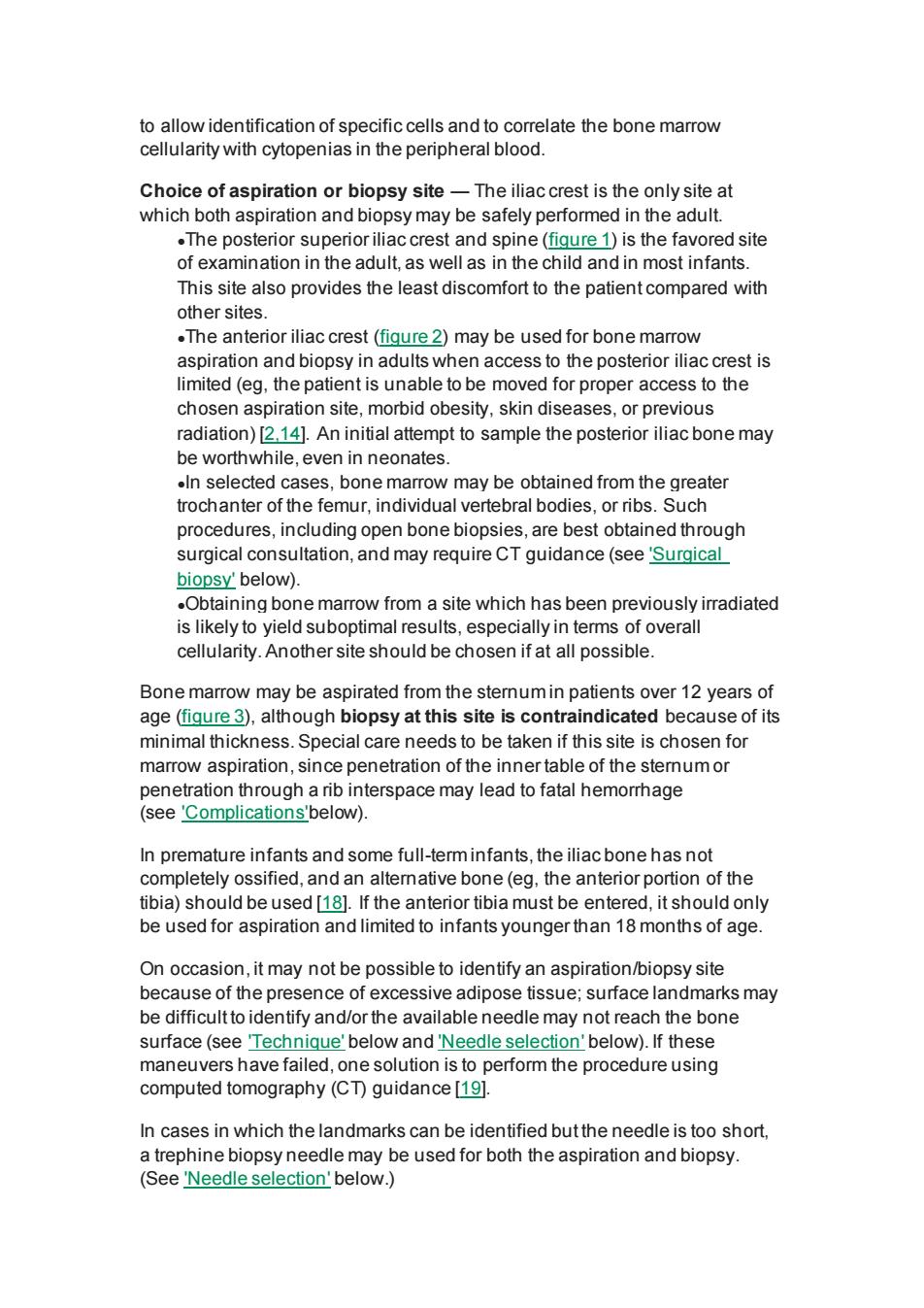正在加载图片...

to allow identification of specific cells and to correlate the bone marrow cellularity with cytopenias in the peripheral blood Choice of aspiration or biopsy site-The iliac crest is the only site at which both aspiration and biop sy may be safely performed in the adult. .The poste superior ilia cres nd spine(fiqure 1)is the favore ed site of examination in the adult,as well as in the child and in most infants This site also provides the least discomfort to the patient compared with other sites. .The anterior iliac crest(fiqure 2)may be used for bone marrow as n nd biopsy in ad when access the posterior ilia crest is limited (eg,the patient is unable to be moved for proper access to the chosen aspiration site.morbid obesity.skin diseases.or previous radiation)[2.14].An initial attempt to sample the posteror iliac bone may be worthwhile even in neonates b may be rnbs.s8eater obtained fro m the trochanter of th ur,individu vertebral bodies IC procedures,including open bone biopsies,are best obtained through surgical consultation,and may require CT guidance(see 'Surgical iopsy'below). .Obtaining bone marrow fro m a site which has been previously irradiated o yield subopt espe overa cellularity.Another site should be chosen if at all possible. Bone marrow may be aspirated from the stemumin patients over 12 years of age(fiqure 3),although biopsy at this site is contr because of it minimal thickness.Special care needs to be taken if this site is chosen for marrow aspiration,since penetration of the inner table of the stemnum or penetration through a rib interspace may lead to fatal hemorrhage (see 'Complications'below). In premature infants and some full-terminfants,the iliac bone has not completely ossified,and an altemative bone(eg,the anterior portion of the tibia)should be used [18).If the anterior tibia must be entered,it should only b sed for aspiration and limited to infants younger than 18months of age On occasion,it may not be possible to identify an aspiration/biopsy site e cause of t ence of excessive adipose tissue;su rface landmarks s may be difficult to identify and/or the available needle may not reach the bone surface (see 'Technique'below and'Needle selection'below).If these maneuvers have failed,one solution is to perform the procedure using computed tomography (CD quidance [191. In cases in which the landmarks can be identified but the needle is too short, a trephine biopsy needle may be used for both the aspiration and biopsy. (See 'Needle selection'below.)to allow identification of specific cells and to correlate the bone marrow cellularity with cytopenias in the peripheral blood. Choice of aspiration or biopsy site — The iliac crest is the only site at which both aspiration and biopsy may be safely performed in the adult. ●The posterior superior iliac crest and spine (figure 1) is the favored site of examination in the adult, as well as in the child and in most infants. This site also provides the least discomfort to the patient compared with other sites. ●The anterior iliac crest (figure 2) may be used for bone marrow aspiration and biopsy in adults when access to the posterior iliac crest is limited (eg, the patient is unable to be moved for proper access to the chosen aspiration site, morbid obesity, skin diseases, or previous radiation) [2,14]. An initial attempt to sample the posterior iliac bone may be worthwhile, even in neonates. ●In selected cases, bone marrow may be obtained from the greater trochanter of the femur, individual vertebral bodies, or ribs. Such procedures, including open bone biopsies, are best obtained through surgical consultation, and may require CT guidance (see 'Surgical biopsy' below). ●Obtaining bone marrow from a site which has been previously irradiated is likely to yield suboptimal results, especially in terms of overall cellularity. Another site should be chosen if at all possible. Bone marrow may be aspirated from the sternum in patients over 12 years of age (figure 3), although biopsy at this site is contraindicated because of its minimal thickness. Special care needs to be taken if this site is chosen for marrow aspiration, since penetration of the inner table of the sternum or penetration through a rib interspace may lead to fatal hemorrhage (see 'Complications'below). In premature infants and some full-term infants, the iliac bone has not completely ossified, and an alternative bone (eg, the anterior portion of the tibia) should be used [18]. If the anterior tibia must be entered, it should only be used for aspiration and limited to infants younger than 18 months of age. On occasion, it may not be possible to identify an aspiration/biopsy site because of the presence of excessive adipose tissue; surface landmarks may be difficult to identify and/or the available needle may not reach the bone surface (see 'Technique' below and 'Needle selection' below). If these maneuvers have failed, one solution is to perform the procedure using computed tomography (CT) guidance [19]. In cases in which the landmarks can be identified but the needle is too short, a trephine biopsy needle may be used for both the aspiration and biopsy. (See 'Needle selection' below.)